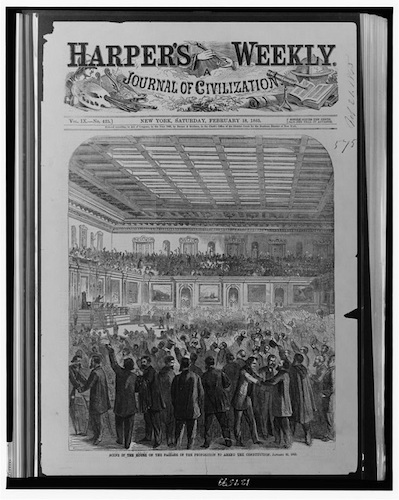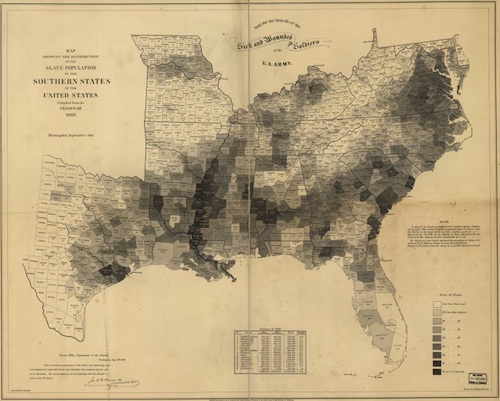Peirspictiochtai Ar An Saol
Juneteenth
Emancipation Celebrations
Part Four
 The scene in the U S House of Representatives on the passage of the proposition to amend the Constitution, according to the Library of Congress, on January 31, 1865. (The illustration was in Harper's Weekly and was provided courtesy of the Library of Congress, February 18, 1865.)
The scene in the U S House of Representatives on the passage of the proposition to amend the Constitution, according to the Library of Congress, on January 31, 1865. (The illustration was in Harper's Weekly and was provided courtesy of the Library of Congress, February 18, 1865.)
Slavery had been part of the United States of America from the birth of the country. In some cases, slavery was outlawed by official actions of individual states and commonwealths. In some cases, slaves were set free by their owners. In other cases, slaves bought their freedom from their owners.
(Those words may strike some as offensive. The dilemma is that at the time of legal slavery, human beings held in bondage were considered property. As offensive as it may seem, the reality was that human beings could – and did – own other human beings as property.)
To put legal slavery in context, consider the percentages of human beings held as slaves in the year prior to the start of the American Civil War. The map at the end of this news column illustrates the level of slavery in parts of the country in 1860. This map shows the distribution of the slave population of the Southern States of the United States. The darker areas of the map indicated a higher percentage of the population in the specific counties were slaves; the lighter areas of the map indicated a lower percentage of the population in the specific counties were slaves. Specific percentages are listed with the county names.
The U S Census Bureau detailed the source of the map as "Commercial lithographer Henry S. Graham printed this choropleth map showing the distribution of the slave population in September 1861. The map shows in graphic terms the density of the slave population in the Southern states, based on figures from the 1860 census. Although the development of this map was a collaborative government effort, cartographers working for Edwin Hergesheimer, U.S. Coast Survey Drafting Division, created it."
To view a larger version of this map, please click here.
https://www.census.gov/history/pdf/1860_slave_distribution.pdfÂ
Slavery for most people in the United States of America ended with the passage of the 13th Amendment to the U S Constitution. According to the U S Congress, the text for this amendment is as follows:
Thirteenth Amendment
Section 1
Neither slavery nor involuntary servitude, except as a punishment for crime whereof the party shall have been duly convicted, shall exist within the United States, or any place subject to their jurisdiction.
Section 2
Congress shall have power to enforce this article by appropriate legislation.
According to The U S National Archives and Records Administration (National Archives), the 13th Amendment to the U S Constitution was passed by U S Congress on January 31, 1865, and was ratified on December 6, 1865.
The National Archives provided a detailed summary of what led to this specific amendment to the U S Constitution:
"'In 1863 President [Abraham] Lincoln issued the Emancipation Proclamation declaring 'all persons held as slaves within any State, or designated part of a State, the people whereof shall then be in rebellion against the United States, shall be then, thenceforward, and forever free.' Nonetheless, the Emancipation Proclamation did not end slavery in the nation since it only applied to areas of the Confederacy currently in a state of rebellion (and not even to the loyal 'border states' that remained in the Union). [The Emancipation Proclamation also specifically exempted certain areas of the Confederate States of America that were already under the control of the Union Army.]
"[President] Lincoln recognized that the Emancipation Proclamation would have to be followed by a constitutional amendment in order to guarantee the abolishment of slavery."
"The 13th Amendment was passed at the end of the Civil War before the Southern states had been restored to the Union, and should have easily passed in Congress. However, though the [U S] Senate passed it in April 1864, the [U S] House [of Representatives] initially did not. At that point, [President] Lincoln took an active role to ensure passage through Congress. He insisted that passage of the 13th Amendment be added to the Republican Party platform for the upcoming 1864 Presidential election. His efforts met with success when the [U S] House [of Representatives] passed the bill in January 1865 with a vote of 119–56.
"On February 1, 1865, President Abraham Lincoln approved the Joint Resolution of Congress submitting the proposed amendment to the state legislatures. The necessary number of states (three-fourths) ratified it by December 6, 1865. The 13th Amendment to the United States Constitution provides that 'Neither slavery nor involuntary servitude, except as a punishment for crime whereof the party shall have been duly convicted, shall exist within the United States, or any place subject to their jurisdiction.'
"With the adoption of the 13th Amendment, the United States found a final constitutional solution to the issue of slavery. The 13th Amendment, along with the 14th and 15th [Amendments], is one of the trio of Civil War amendments that greatly expanded the civil rights of Americans."
The 13th Amendment to the U S Constitution, though, did not end slavery in the entire country.
While the passage of the 13th Amendment applied to the areas under the jurisdiction of the United States, it did not apply to sections of what is today the State of Oklahoma. At the time, much of Oklahoma was the Indian Territory.
Emancipation of all of the slaves in this region did not occur until four treaties were signed between the United States and five Native American nations located in the Indian Territory in 1866.
Specifically, the treaty with the Seminole Nation on March 21, 1866; the treaty with the Choctaw Nation and the Chickasaw Nation on April 28, 1866; the treaty with the Creek Nation (Muscogee Nation) on June 14, 1866; and the treaty with the Cherokee Nation on July 19, 1866.
Further details about slavery in these five nations were included in the text of the Extra Census Bulletin – The Five Civilized Tribes In Indian Territory - The Cherokee, Chickasaw, Choctaw, Creek [Muscogee], and Seminole Nations issued by the United States Census Bureau in 1894:
"The negroes, once slaves of The Five Tribes, are of much interest in connection with the final settlement of the land question. The Five Tribes, except the Seminoles, all owned slaves prior to and during the [American Civil] war. These were freed by the proclamation of emancipation, and this was enforced and confirmed, after much protest, by the treaty [actually four separate treaties] of 1866. In 1860, the total number of slaves held by The Five Tribes was 7,369. The Seminoles held no slaves in Indian territory, but they intermarried with negroes. Since the [end of the American Civil] war there has been a very large increase in the negro population of The Five Tribes by immigration from the old slave states adjacent. The negro question in the Cherokee, Chickasaw, and Choctaw Nations, the equities and rights of these people in the lands of The Five Tribes, and as to citizenship. have yet to be properly settled."
Please note that without the enforcement of Federal authority, the U S Constitution and the treaties with the Native American nations were not necessarily effective.
The National Archives indicated that "On August 20, 1866, President [Andrew] Johnson issued a proclamation announcing the end of the American Civil War: 'And I do further proclaim that the said insurrection [the American Civil War] is at an end and that peace, order, tranquility, and civil authority now exists in and throughout the whole of the United States of America.'"
While the actions of individual states and commonwealths, the Federal government, and the five Native American nations all contributed to the end of legal slavery, slavery for some people continued to exist in the United States. In some cases, the wording was different when describing the activities associated with slavery or the format of involuntary servitude was altered.
Today, some in the U S use the wording "human trafficking" when detailing cases of involuntary servitude that could be considered remarkedly similar to legal slavery from years past.
Please note that slavery is still constitutionally allowed in the United States in specific situations.
Recall the portions of the 13th Amendment to the U S Constitution that stated that "…slavery nor involuntary servitude…" shall exist in the United States "…except as a punishment for crime whereof the party shall have been duly convicted…"
 (The map was provided courtesy of the U S Census Bureau, September of 1861.)
(The map was provided courtesy of the U S Census Bureau, September of 1861.)
The next edition of Peirspictiochtai Ar An Saol will include statements from leaders and leading institutions in the United States of America regarding Juneteenth and the end of slavery in this country.
Peirspictiochtai Ar An Saol – Gaelic – Irish – for "Perspectives On Life" is a column focused on aspects of accountability and responsibility as well as ways people look at life.
Contact Richard McDonough at
© 2024 Richard McDonough









